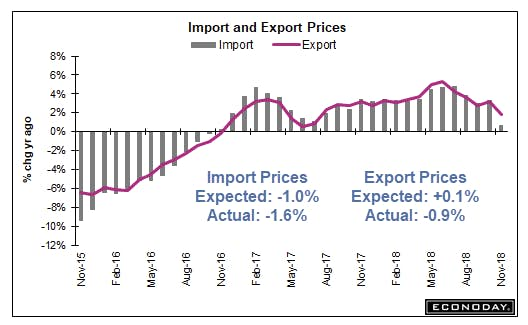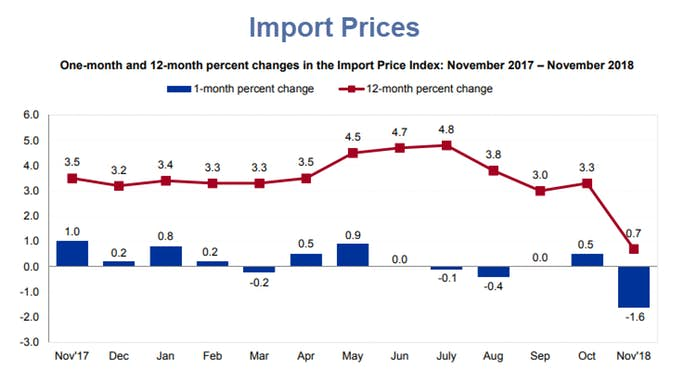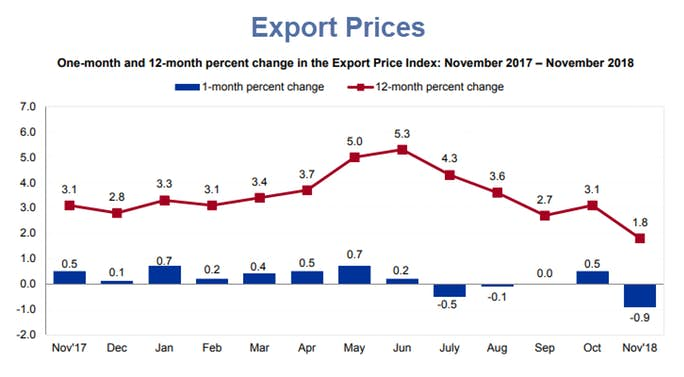
Economists underestimated the magnitude of a decline in import prices and missed the boat entirely on export prices.
Import and Export Price Indexes for November
Economists at Econoday missed the mark badly on import and export prices for November.
Let's dive into the BLS report on Import and Export Prices for more details.
Import Prices
Import Synopsis: Prices for U.S. imports decreased 1.6 percent in November, the largest monthly decline since a 1.8-percent drop in August 2015. Despite the November drop, import prices increased 0.7 percent over the past 12 months, the smallest over-the-year advance since the index increased 0.2 percent from November 2015 to November 2016.
Fuel Imports: Import fuel prices decreased 11.0 percent in November following a 3.2-percent rise the previous month. The November drop was the largest 1-month decline since the index fell 15.6 percent in January 2016. A 12.1-percent decrease in petroleum prices led the November decline in fuel prices and was the largest monthly drop since petroleum prices fell 17.2 percent in January 2016. The November decline in petroleum prices more than offset a 12.8-percent advance in natural gas prices that followed a 22.3-percent increase for that index in October. Despite the decrease in November, fuel prices rose 4.6 percent over the past year. The price index for petroleum increased 4.4 percent for the year ended in November, and natural gas prices advanced 11.6 percent over the same period.
All Imports Excluding Fuel: Prices for nonfuel imports fell 0.3 percent in November, after ticking up 0.1 percent in October. Lower foods, feeds, and beverages prices were the largest factor for the November decline in nonfuel prices, although prices for nonfuel industrial supplies and materials and capital goods also decreased. The price index for nonfuel imports increased 0.3 percent over the past 12 months, driven by higher prices for nonfuel industrial supplies and materials; consumer goods; and automotive vehicles.
Export Prices
Export Price Synopsis: Prices for U.S. exports declined 0.9 percent in November, the largest 1-month decrease since the index fell 0.9 percent in January 2016 and 1.1 percent in December 2015. Lower nonagricultural prices in November more than offset rising agricultural prices. Despite the November decline, U.S. export prices increased 1.8 percent over the past year.
Agricultural Exports: The price index for agricultural exports rose 1.8 percent in November, after falling 0.2 percent in October and 1.2 percent in September. The November advance was the largest increase since the index rose 3.2 percent in March. Higher prices for fruit, soybeans, and corn all contributed to the November increase in agricultural prices. Despite the November increase, agricultural export prices declined 1.7 percent from November 2017 to November 2018. A 10.7 percent drop in soybeans prices and a 12.3 percent decline in nut prices over the past year were the primary factors for the decrease in overall agricultural prices.
All Exports Excluding Agriculture: Nonagricultural export prices fell 1.0 percent in November following a 0.5-percent increase the previous month and a 0.2-percent advance in September. The November drop was the largest monthly decrease since the index declined 1.1 percent in December 2015. Lower nonagricultural industrial supplies and materials prices led the November decrease in nonagricultural export prices, with falling prices for consumer goods and automotive vehicles also contributing to the decline. Despite the decline in November, prices for nonagricultural exports increased 2.2 percent over the past 12 months.
This material is based upon information that Sitka Pacific Capital Management considers reliable and endeavors to keep current, Sitka Pacific Capital Management does not assure that this material is accurate, current or complete, and it should not be relied upon as such.
Recommended Content
Editors’ Picks
EUR/USD edges lower toward 1.0700 post-US PCE

EUR/USD stays under modest bearish pressure but manages to hold above 1.0700 in the American session on Friday. The US Dollar (USD) gathers strength against its rivals after the stronger-than-forecast PCE inflation data, not allowing the pair to gain traction.
GBP/USD retreats to 1.2500 on renewed USD strength

GBP/USD lost its traction and turned negative on the day near 1.2500. Following the stronger-than-expected PCE inflation readings from the US, the USD stays resilient and makes it difficult for the pair to gather recovery momentum.
Gold struggles to hold above $2,350 following US inflation

Gold turned south and declined toward $2,340, erasing a large portion of its daily gains, as the USD benefited from PCE inflation data. The benchmark 10-year US yield, however, stays in negative territory and helps XAU/USD limit its losses.
Bitcoin Weekly Forecast: BTC’s next breakout could propel it to $80,000 Premium

Bitcoin’s recent price consolidation could be nearing its end as technical indicators and on-chain metrics suggest a potential upward breakout. However, this move would not be straightforward and could punish impatient investors.
Week ahead – Hawkish risk as Fed and NFP on tap, Eurozone data eyed too

Fed meets on Wednesday as US inflation stays elevated. Will Friday’s jobs report bring relief or more angst for the markets? Eurozone flash GDP and CPI numbers in focus for the Euro.

